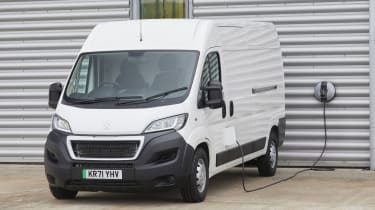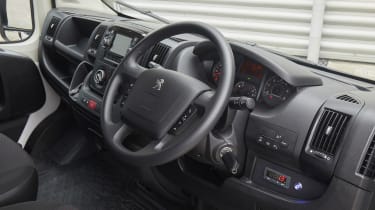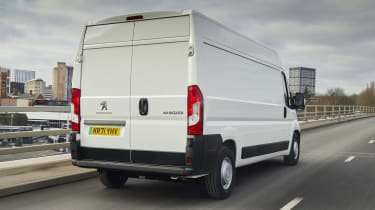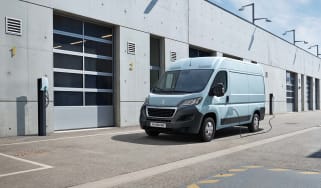Peugeot e-Boxer review
The French brand’s large electric van gets the basics right, but range isn’t the best and its aftermarket-conversion status is very obvious

Pros
- Low running costs
- 50kW rapid charging
- Variety of body sizes
Cons
- Aftermarket conversion – and feels like it
- Some rivals have longer ranges
- Quite expensive
| Model | Range | Wallbox charge time | Maximum cargo volume |
|---|---|---|---|
| 37kWh | 73 miles | 6hrs (0-100%, 7.4kW) | 11.5 cubic metres |
| 75kWh | 154 miles | 12hrs (0-100%, 7.4kW) | 15 cubic metres |
The Peugeot e-Boxer is a large electric van that’s a near-identical sister model to the Citroen e-Relay and Vauxhall Movano-e. The trio all use the same 118bhp electric motor and offer a choice of 37kWh or 75kWh battery capacities, as well as the range of body sizes typical to this class. Rivals include the Renault Master E-TECH, the Mercedes eSprinter, the Maxus eDeliver 9 and the all-important Ford E-Transit.
There’s also the Fiat E-Ducato, winner of our 2022 ‘Best Large Electric Van’ award. Despite looking very similar to the Peugeot/Citroen/Vauxhall triplets, the e-Ducato was actually developed before its Italian maker became part of the Stellantis Group, and so has a slightly different setup to them under the metal. Its biggest battery is larger, at 79kWh, giving a longer maximum range of 230 miles.
For the Peugeot, the longest range you can get is 154 miles with the 70kWh battery, or a pretty limited 73 miles from the 37kWh model. As these numbers suggest, the e-Boxer is another large electric van designed specifically for carrying out urban ‘multi-drop’ deliveries. It does have 50kW rapid-charging capability, however, so a top-up from zero to 80% capacity can be completed in around an hour while out and about.
Slower charging overnight can be carried out at up to 22kW, which will have the 37kWh battery full in three hours or the 75kWh unit done in nine hours. Charging at that rate is usually only possible at commercial premises with three-phase electricity; if you’re stuck using a standard 7.4kW domestic wallbox, charging times balloon to six or 12 hours respectively for the smaller and larger batteries.
Climbing aboard, the e-Boxer’s cabin will look familiar to anyone who’s driven the diesel Boxer, or any of its sister models. There’s no gearlever; instead, you get three simple buttons to select either ‘Drive’, ‘Neutral’ or ‘Reverse’. It’s straightforward to use, but this is one area where it’s obvious the e-Boxer’s conversion to electric power has been carried out by a third-party factory: the switches have a distinctly aftermarket feel about them, as does the button to switch on the cabin heater, down to the right of the steering wheel.
Another feature that feels somewhat tacked-on is the battery charge level display, which is integrated into the rear-view mirror, instead of – as you might reasonably expect – appearing in the five-inch touchscreen display. Finally, there’s the bizarre touch of the diesel Boxer van’s dials having been retained in their entirety, leaving you looking at redundant engine rev, water temperature and fuel gauges, minus their needles.
In truth, many van drivers and operators won’t be bothered by these cobbled-together aspects of the e-Boxer, as long as it can do the jobs asked of it. To lay one potential concern to rest, there’s no reduction in load space compared to the diesel equivalent: the van’s capacity ranges from 11.5 cubic metres in the smallest L2H2 body configuration (only available with the 37kWh battery) to 15 cubic metres in the the L4H2 arrangement (only available with the 70kWh battery). Maximum payloads run from 740kg to 1.15 tonnes.
For such a large van, 118bhp is a pretty paltry power output, and that’s exactly how it feels on the road. You don’t get the instant jolt of acceleration that characterises electric passenger cars; instead, there’s a sedate and gradual increase in speed when you put your foot down. This means care is required on busy roundabouts or when merging on to a fast A-road or motorway.
In better news, while it’s certainly not fast, the e-Boxer is much quieter and more relaxing to drive than any diesel-engined van. There is a bit of an audible whistle from the electric motor, however, which might become grating in the course of a full day behind the wheel.
Once you’re up to speed, the e-Boxer cruises along reasonably well, but at motorway speeds, range starts to drop steeply – this van is definitely more at home in urban environments. There is a regenerative braking effect when you lift off the throttle, but we found it rather inconsistent – and there’s no ability to adjust the strength of the effect yourself.
Adding to the Peugeot’s urban-friendly credentials, it has light steering, plus the simplicity of switching between drive and reverse we’ve mentioned already. Rear parking sensors are standard, which is very welcome on a 5.4-metre-long vehicle, however forward visibility isn’t the best, due to the position and size of the e-Boxer’s window pillars and door frames.
At the end of the day, the e-Boxer feels like a fairly rough-and-ready option for those in the market for a large, short-range van, needing sheer cargo volume rather than the highest payload. Unlike some rivals, it’s available for delivery straight away, but if you can afford to wait before switching to electric, both the Fiat E-Ducato and Ford E-Transit are simply more polished and capable products than the Peugeot.




